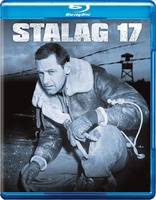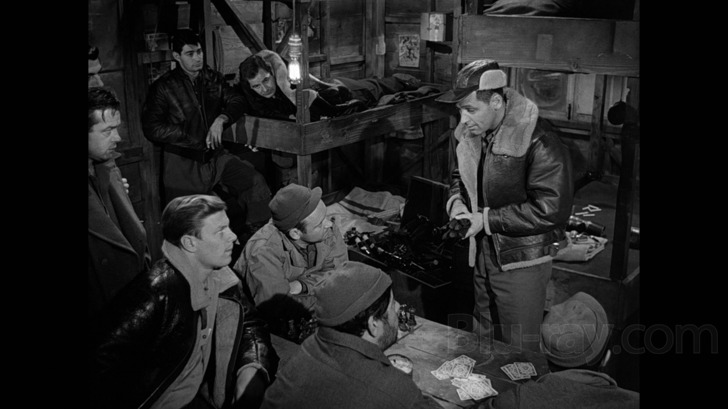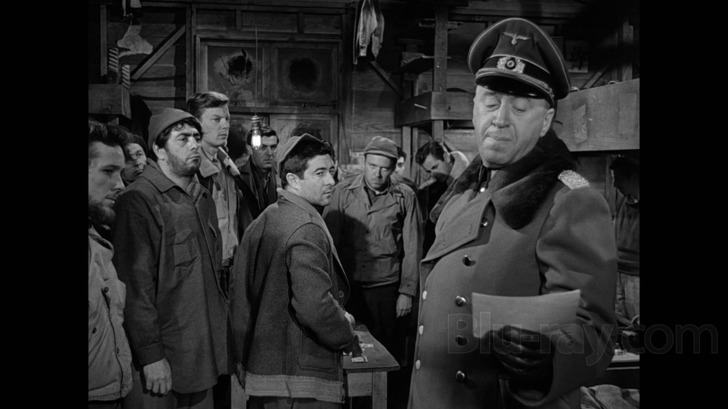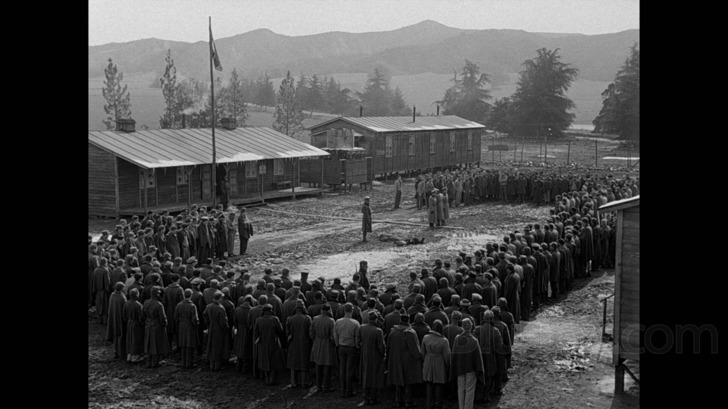Stalag 17 Blu-ray Movie
HomeStalag 17 Blu-ray Movie 
Warner Bros. | 1953 | 121 min | Not rated | Oct 08, 2013
Movie rating
7.9 | / 10 |
Blu-ray rating
| Users | 4.3 | |
| Reviewer | 4.5 | |
| Overall | 4.3 |
Overview
Stalag 17 (1953)
A cynical serviceman in a World War II POW camp has to prove he's not an informer.
Starring: William Holden, Don Taylor (I), Otto Preminger, Robert Strauss, Harvey LembeckDirector: Billy Wilder
| Drama | Uncertain |
| War | Uncertain |
| Comedy | Uncertain |
Specifications
Video
Video codec: MPEG-4 AVC
Video resolution: 1080p
Aspect ratio: 1.35:1
Original aspect ratio: 1.37:1
Audio
English: DTS-HD Master Audio Mono (48kHz, 24-bit)
French: Dolby Digital Mono
Spanish: Dolby Digital Mono (224 kbps)
Mono=2.0
Subtitles
English SDH, French, Spanish
Discs
25GB Blu-ray Disc
Single disc (1 BD)
Playback
Region free
Review
Rating summary
| Movie | 5.0 | |
| Video | 4.5 | |
| Audio | 4.0 | |
| Extras | 2.5 | |
| Overall | 4.5 |
Stalag 17 Blu-ray Movie Review
Who Do You Trust?
Reviewed by Michael Reuben October 7, 2013Stalag 17 ranks with The Great Escape and The Bridge on the River Kwai as one of the greatest films about POWs in World War II, but it came first and it has the distinction of conveying intense drama on an intimate scale. Tunnels are dug, but you don't struggle through the painstaking process. Escapes occur, but you never follow the fleeing prisoners outside the camp. There are no dramatic vistas of foreign landscapes to convey the depth of the prisoners' isolation and the distance that separates them from home. Most of the film unfolds inside a crowded barracks, where everything is conveyed through the expressions, conflicts, fights, dreams and frustrations of the motley crew forced to cooperate in mutual resistance against their Nazi captors. Perhaps the most distinctive quality of Stalag 17 is how funny it is, which is what immediately captured director Billy Wilder's attention when he saw the original Broadway play by Edmund Trzcinski and Donald Bevan, both former POWs. An inveterate mixer of genres, Wilder responded to the play's gallows humor, and even though he and co-author Edwin Blum rewrote most of the dialogue, routinely handing the cast new pages on the day of shooting, they retained the story's distinctive combination of pitch black comedy and desperate farce, as the camp's prisoners do their best to keep up their spirits under the watchful eyes of guard dogs, machine guns and a commandant determined to break their spirits. Wilder, a Viennese Jew who had fled the Nazis, well understood the need to crack wise in the face of evil. William Holden originally declined the lead role of Sgt. J.J. Sefton, an independent entrepreneur reminiscent of Rick in Casablanca, who is suspected by everyone of collaboration, but Wilder persuaded him to take it and then fought Holden at every turn when the star wanted to make Sefton more sympathetic. Wilder knew what he was doing, because the role won Holden the Oscar for Best Actor. Holden famously treated the award as a consolation prize for losing three years earlier for Sunset Blvd., but he was selling himself short. Watch Sefton calculate "the odds", dominate every scene he's in and, in retrospect, redefine the notion of what it means to be a hero, and the special quality of Holden's performance becomes evident. (For the record, the film was also nominated for Wilder's direction and for Robert Strauss's memorable supporting performance as "Animal".)

The film is narrated by Sgt. Clarence Harvey Cook (Gil Stratton), known as "Cookie", who speaks more in voiceover than he does in dialogue. He's tired of all those films about fighting men, he explains at the outset. He'd like to see one about POWs—like that time he and his fellow prisoners had a German spy among them . . . And with that Wilder begins introducing the inhabitants of Barracks 4, all of them sergeants, as they finalize the escape plans for two of their number, Manfredi and Johnson (Michael Moore and Peter Baldwin). The barracks leader, "Hoffy" Hoffman (Richard Erdman), has approved the attempt, and the official head of security, Price (Peter Graves), has cleared every possible risk. But Sefton (Holden) doesn't like the odds. He bets two packs of cigarettes that the escape will fail, and he's right. The Germans are waiting for the men at the other end of their tunnel. No one can figure out how the Nazis knew, and suspicion grows that they have a spy among them. Sefton seems the likely candidate, because he lives so much better than anyone else. "Everybody here is trading", Sefton explains. "So maybe I trade a little sharper. That make me a collaborator?" Sefton has the place so wired that he even manages to bribe guards to let him into the Russian women's quarters, where his fellow inmates can only gawk and fantasize. (The camp holds Poles and Czechs as well, but the nationalities are segregated.) The prisoners engage in acts of daily resistance, while attempting to keep up their spirits. The bulk of the comic relief falls to Stanislaus "Animal" Kuzawa (Robert Strauss), a heavy sleeper with a Betty Grable fixation, and his buddy, Harry Shapiro (Harvey Lembeck, reprising his Broadway performance), who alternately torments and tries to comfort his massive friend. Everyone tries to shield shell-shocked Joey (Robinson Stone) from the harshest aspects of camp life; Joey never says a word but simply plays his ocharina. A poignantly comical bit is provided by "Triz" (the original play's co-author Edmund Trzcinski), who gets a truly unbelievable "Dear John" letter from his wife, but keeps repeating: "I believe it!" The camp commandant, a domineering tyrant named Oberst von Scherbach, is played by famed producer/director Otto Preminger, who, like Wilder, was Jewish but used his dictatorial directing style to great effect as a Nazi. A former cavalry officer, von Scherbach is an eccentric who puts on his riding boots just to make a telephone call to Berlin—a detail that that Wilder supplied, no doubt with great delight. Von Scherbach's liaison to Barracks 4 is the jovial Sergeant Johann Sebastian Schulz (Sig Ruman, who played "Concentration Camp" Ehrhardt in Ernst Lubitsch's To Be or Not to Be). No secret seems to be safe from them, and Wilder neatly reveals their method of communication long before the spy's identity is disclosed. Indeed, Wilder didn't tell the cast who the spy was until three days before the production wrapped, lest any hint in their performance give away the secret. Matters become dire with the arrival of Lt. James Dunbar (Don Taylor), who is temporarily housed with the sergeants until he can be shipped to an officers' camp. To his fellow prisoners Dunbar confides his responsibility for an act of sabotage that destroyed a Nazi arms shipment and crippled the railroad system. When he is almost immediately arrested by von Scherbach as a saboteur, the men beat Sefton savagely for his assumed betrayal, then set about planning a rescue before the Gestapo can arrive to transport Dunbar to Berlin. A Red Cross inspection of the camp provides an opportunity (and an unexpected form of material support), but before Dunbar can be safely smuggled out of the camp, there must be a final reckoning with the traitor among them. It's sometimes hard to believe that most of Stalag 17 was filmed on soundstages at Paramount Studios with just a week or two of shooting at a mud-filled exterior in the San Fernando Valley. So well-structured is the script and so effective the performances that viewing the film takes you into a whole other world that feels much larger. Wilder and his talented cast create a microcosm of the European war within this tightly woven group of POWs fighting their captors. Their frustrations, loyalties, will to survive and determination to continue the fight and make it home are filled out with such memorable detail that these characters seem to have a life beyond the screen. But the Wilder touch remains evident to the end. It's the Christmas season when the lights go down, but there's nothing sentimental in the air. The last words we hear are a wisecrack steeped in the kind of worldly cynicism that J.J. Sefton himself would appreciate.
Stalag 17 Blu-ray Movie, Video Quality 

Wilder was famously contemptuous of films that called attention to their style, but he always used good cinematographers. Stalag 17 was shot by Ernest Laszlo, who would later win an Oscar for the delicate black-and-white imagery of Ship of Fools (1965) and also created the widescreen comic mayhem of It's a Mad, Mad, Mad, Mad World (1963). Laszlo's imagery for Stalag 17 gave Paramount executives heartburn, because it showed every speck of muck and grime on the prison camp POWs, which is exactly what Wilder wanted. It's all visible on Warner's 1080p, AVC-encoded Blu-ray of this Paramount catalog title, where the depth and detail of Laszlo's precise lighting is truly impressive. Wilder maintained a sense of the camp's crowded conditions by staging scenes in group tableaus, with multiple activities happening at once, and Laszlo's clear focus, deep blacks and finely delineated shades of grade provide depth and clarity throughout. The Blu-ray's image brings this effect to home video with a finely grained image, superb detail and only an occasional (very occasional) soft shot to suggest any generational loss. The source material either is in pristine condition or has been expertly restored, and there is no indication of any untoward digital tampering to slant the look of the film toward modern video tastes. Stalag 17 looks like a classic B&W film from the Fifties, except that Wilder's films are timeless. The average bitrate of 18.97 Mbps might appear low, but it should be remembered that the film is B&W with solid black windowbox bars. The lower average bitrate is appropriate, and compression issues were not in evidence.
Stalag 17 Blu-ray Movie, Audio Quality 

The film's original mono soundtrack has been presented as lossless DTS-HD MA 2.0, with identical front left and right channels. It sounds quite good for a film of this vintage. The dialogue is exceptionally clear, which always essential for a Wilder film, and the sound effects of machine guns, trucks, pounding on doors, etc. have decent dynamic range. The minimal score by an uncredited Franz Waxman (Sunset Blvd.) achieves exactly the right effect.
Stalag 17 Blu-ray Movie, Special Features and Extras 

Paramount first released Stalag 17 on DVD in 1999 with no features. In 2006, Paramount released a "Special Collector's Edition" with an array of extras that have been ported over to this Blu-ray. The only extra not included is a photo gallery.
- Commentary with Actors Richard Erdman and Gil Stratton and Co-Playwright Donald Bevan: By the time anyone got around to recording a commentary, many of the principals had passed away and those who remained were well into their 80s. Although Bevan co-wrote the play, his involvement with filming was minimal, and he admits that he didn't much care for the film when he first saw it. Erdman played compound chief Hoffy, and Stratton played Sefton's gofer and the film's narrator, Cookie. They share their recollections, but it's clearly an effort, and there are long pauses, especially in the latter half of the film. Many of the actors' stories are repeated in the "From Reality to Screen" featurette, but Bevan adds several intriguing anecdotes from his own time as a POW.
- Stalag 17: From Reality to Screen (480i; 1.33:1; 22:01): This mini-documentary on the making of Stalag 17 has to rely largely on secondary sources, because most of the participants were no longer alive when it was made in 2006. Erdman, Stratton and Bevan are interviewed, but the other interviewees are all scholars and fans. They include writer/director Nicholas Meyer, Rob Thomas (Holden's biographer) and Ed Sikov (Wilder's biographer).
- The Real Heroes of Stalag XVII B (480i; 1.33:1; 24:49): Bevan and other real-world POWs relate their experiences. They are joined by several military experts, including USMC Capt. Dale Dye, now an actor and military advisor to the movies.
Stalag 17 Blu-ray Movie, Overall Score and Recommendation 

Anyone familiar with the TV series Hogan's Heroes, which ran from 1965-1971 on CBS, will find it almost impossible to watch Stalag 17 without assuming that the film inspired the show (which also featured a jolly barracks guard named Sgt. Schulz). The notion of a comedy set in a prison camp where the prisoners made fun of their German captors was deemed so outlandish at the time that it was hard to believe that the creators hadn't taken their cue from Wilder's film, which had been a huge commercial success. A lawsuit between the creators of Hogan's Heroes and the authors of Stalag 17 was settled for an undisclosed amount, and as is typical in settlements, the creators of the TV show denied all liability. Whatever one may think of the dispute, Hogan's Heroes was never more than a watered-down version of the twisted comedy that Wilder directed. In the TV show, danger was never real, but in Wilder's film it is omnipresent. Wilder uses the initial, unsuccessful escape attempt to show the life-threatening jeopardy in whose shadow his film's characters live every day. Their humor has an extra bite of anxiety, and not everyone is able to bring it off, e.g., Duke (Neville Brand), who is always on the edge of an explosion. No one understood the comedy of desperation better than Billy Wilder, whether in the executive suite, on the run from the mob or in a German POW camp. Highly recommended.
Other editions
Stalag 17: Other Editions
Similar titles
Similar titles you might also like

The Bridge on the River Kwai
1957

The Colditz Story
1955

Merry Christmas Mr. Lawrence
1983

To Be or Not to Be
1942

The Dirty Dozen
1967

Lifeboat
1944

Hart's War
2002

Seven Beauties
Pasqualino Settebellezze
1975

The Life and Death of Colonel Blimp
1943

The Great Escape 4K
1963

La Grande Illusion
Grand Illusion
1937

Where Eagles Dare
1968

The Counterfeiters
Die Fälscher
2007

The Eagle Has Landed
1976

The Deer Hunter 4K
Collector's Edition
1978

Ice Cold in Alex
1958

The Great Raid
Unrated Director's Cut
2005

The Great Dictator
1940

The Virgin Soldiers
Limited Edition to 3000
1969

Spies of Warsaw
2012



